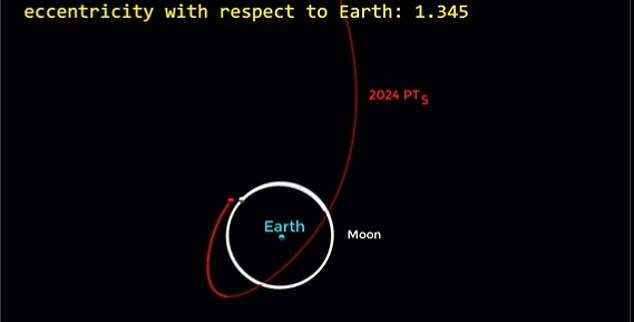Secrets of Earth’s ‘second moon’ revealed
Scientists have discovered the origin of an asteroid the size of a school bus that has been hanging around the edge of our orbit for two months.
Asteroid 2024 PT5 was dubbed Earth’s temporary “second moon” due to its size and persistent presence so close to our planet.
Astronomers collected data about the asteroid as it orbited Earth it could be a piece of our moon that broke off in one of the collisions that left the moon’s surface marred with craters.
The leading theory of the moon’s formation is the “giant impact hypothesis,” which states that the moon is actually a huge chunk of Earth orbiting the Earth.
According to this theory, our planet collided with a planet the size of Mars about four billion years ago, causing an explosion of material from Earth that shot into space and eventually condensed to form the moon.
If the giant impact hypothesis and the analysis of the origin of asteroid 2024 PT5 are correct, it would mean that our true moon is the parent of this mini-moon, and Earth is its grandparent.
The second moon begins its journey away from Earth today as it is pulled into space by the Sun’s gravity.
New analysis of Earth’s ‘second moon’ suggests this orbiting space rock visited its heavenly family for Thanksgiving (STOCK)
“There are several lines of evidence that indicate that this asteroid may have come from the moon,” said Carlos de la Fuente Marcos, lead author of the study and professor at the Universidad Complutense de Madrid, told Space.com.
“The current study favors a fast rotation with a rotation period of less than an hour, which is to be expected if PT5 is either a large boulder from the moon’s surface or a fragment of a larger object in 2024.”
He and his brother, Raul de la Fuente Marcos of the Universidad Complutense de Madrid, identified the asteroid’s mini-moon behavior.
As the asteroid traveled around the outer edge of Earth’s orbit, the astrophysicists used telescopes in Spain’s Canary Islands to collect hundreds of observations of the asteroid.
They analyzed its spectra, or the range of electromagnetic wavelengths it emits. This data indicated that the asteroid’s chemical composition matches that of lunar material previously returned to Earth.
The researchers’ findings are currently available on the preprint server arXiv and have been accepted for publication by the journal Astronomy & Astrophysics.
Asteroid 2024 PT5 was first spotted in August and became entangled in Earth’s gravity in September.
It emerged from the Arjuna asteroid belt, a group of asteroids that orbit the sun at an average distance of about 93 million miles and follow a path similar to Earth’s orbit.

The space rock followed a horseshoe-shaped path around Earth for about two months, giving astronomers like the de la Fuente brothers ample time to study this mini-moon
“Some Arjuna objects from the asteroid belt may approach Earth at a close distance of about 2.8 million miles (4.5 million kilometers) and at a relatively low speed of less than 2,200 miles per hour (3,540 km per hour),” Carlos de la Fuente Marcos said. . Space.com.
‘Asteroid 2024 PT5 will not complete a full orbit around the Earth. You could say that if a real satellite is like a customer buying goods in a store, objects like 2024 PT5 are window shoppers.”
In fact, NASA has emphasized that this asteroid never fully entered our planet’s orbit, meaning it was never technically a moon. But it is “an interesting object” worth studying, the agency said.
To be considered a mini-moon, an asteroid must come within 2.8 million miles of Earth and approach at a relatively slow speed of about 2,000 miles per hour, according to Carlos de la Fuente Marcos.
The space rock followed a horseshoe-shaped path around Earth for about two months, giving astronomers like the de la Fuente brothers plenty of time to study this mini-moon.
It is currently over two million miles from our planet and will gradually start moving further away today.
Asteroid 2024 PT5 will approach Earth again in January, at a distance of about 1.8 million kilometers from our planet. It will then zoom out into the cosmos again and will not return again until 2055.
‘I won’t really be sad if PT5 disappears in 2024; mini-moons come and go as they please. I’m just waiting for the next one,” Carlos de la Fuente Marcos told Space.com.
‘That wait won’t be long; the next capture will probably take place within a few months. The ongoing Near Earth Object surveys are now sensitive enough to pick up these objects regularly.’
